(NewsNation) — Slides and swings aren’t the typical things you’d see on prison grounds, but the York Correctional Institution wants the women behind bars to better connect with families who come to visit.
The warden, Trian Sexton, has long thought about innovative ways to better connect the women inside with their families on the outside
“I got the idea that well, why don’t we have a playground? That’s just another way for parents to connect with their children,” she said.
It’s the first prison-based playground in the state, and took help from the Institute for Municipal and Regional Policy (IMRP) at the University of Connecticut to make it happen.
IMRP’s Aileen Keays said it goes beyond providing visitors with a fun activity. Research shows building bonds among family members lowers recidivism rates for people who are regularly visited by family when they’re incarcerated.

“It’s also been demonstrated to improve institutional behavior, which of course then benefits the correctional officers and the entire environment,” Keays said, adding that children who get to see their parents more often also benefit.
Sexton said she’s gotten positive feedback from the nearly 400 mothers behind bars at York Correctional, especially those who were unable to physically see their kids for three years because of the pandemic.
“The women are very happy that their kids have a place to go and that they have a place to interact with them, even if it’s just creating a sense of normalcy while they’re here,” she said.
Sexton did, however, emphasize that the playground is only one component in their strategy to connect parents to their children. She said the facility offers prenatal and parenting education programs to help build that bond.
“There’s a solid foundation that needs to be built,” she said.
Keays acknowledged that there can be political obstacles to spending more money on incarcerated parents. In this case, the Connecticut State Assembly has specifically set aside money to benefit children with incarcerated parents; the IMRP was able to use $50,000 from those funds to pay for the playground.
She argued that projects like the playground can benefit an entire community, not just incarcerated people and their families.
“The behavioral challenges for children with incarcerated parents who are not getting support can be really significant. And that impacts the classroom. And that impacts your children,” Keays said.
